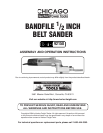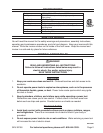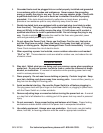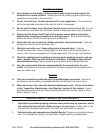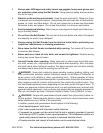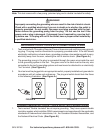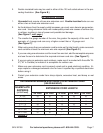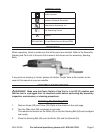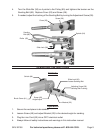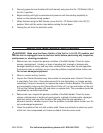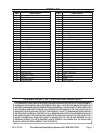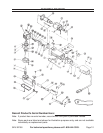
Page 10SKU 92158
For technical questions, please call 1-800-444-3353.
5. Securely grasp the tool handle (with both hands) and press the On / Off Switch (48) to
the On (I) position.
6. Begin sanding with light movements and pressure until the sanding capability is
known on the material being sanded.
7. When finished using the Belt Sander, press the On / Off Switch (48) to the Off (O)
position. Wait until the motor stops before setting the tool down.
8. Unplug the unit from the electrical outlet.
INSPECTION, MAINTENANCE, AND CLEANING
WARNING! Make sure the Power Switch of the Tool is in its Off (O) position and
that the tool is unplugged from its electrical outlet before performing any inspection,
maintenance, or cleaning procedures.
1. Before each use, inspect the general condition of the Belt Sander. Check for loose
screws, misalignment , binding, or tears of sanding belt, cracked or broken parts,
damaged electrical wiring, and any other condition that may affect its safe operation.
If abnormal noise or vibration occurs, have the problem corrected before further use.
Do not use damaged equipment.
2. Store in a clean and dry location.
3. Inspect the Carbon Brushes every few months for excessive wear; Sooner if the tool
is used daily. Over time, if the performance of the tool diminishes, or it stops working
completely, it may be necessary to replace the motor’s Carbon Brushes. The brushes
are accessed by removing the Carbon Brush Cover (41) on top and bottom of the unit.
Pull out the Carbon Brushes (40) and clean or replace both. This procedure should be
completed by a qualified technician.
4. Before each use, inspect the general condition of the Belt Sander. Check for loose
screws, misalignment or binding of moving parts, cracked or broken parts, damaged
electrical wiring, and any other condition that may affect its safe operation. If
abnormal noise or vibration occurs, have the problem corrected before further use. Do
not use damaged equipment.
5. Clean the outside of the unit with a damp cloth. Never use solvents to clean any parts
of this tool. Use compressed air to blow out debris from the motor vents.



